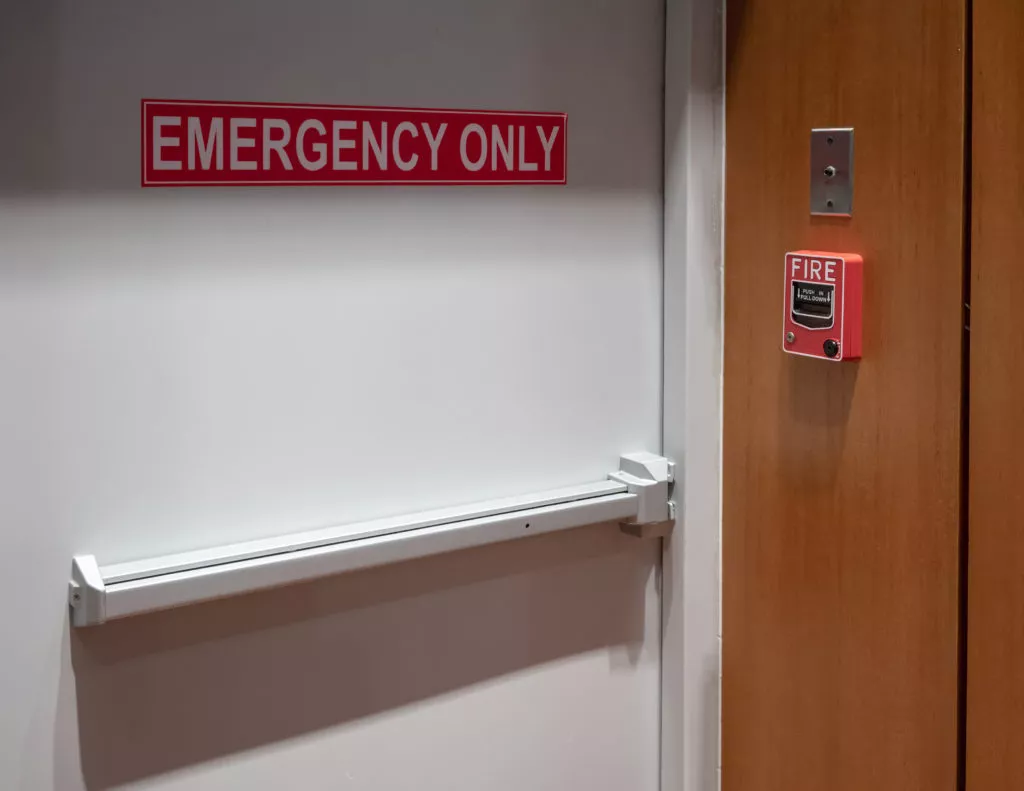Where Is Panic Door Hardware Required?

The ability to exit a room quickly and safely in an emergency is essential in facilities that are open to the public. According to the International Building Code, if your building features an assembly, educational, or high-hazard area with more than 50 occupants, nearly all egress doors that latch closed must have panic hardware installed for quick exits in an emergency. The panic hardware will affect the types of access control and security solutions that can be used while still enabling emergency egress.
Controlled Access and Free Egress
In all but a few situations, any access control system installed on a door that requires panic hardware must allow the door to be opened quickly, in one motion, without needing any prior knowledge or training on the door’s operation. Typically, this is accomplished with an access control reader outside the door to allow authorized personnel to enter and panic hardware on the inside to allow free egress. The latch can be fixed open to allow free access in and out, or if the door needs to remain locked, electrified lever trim, latch retraction, strikes, or locks may be used to latch the door while maintaining free egress. There are some exceptions to the free egress requirements, which are discussed below.
Controlled Egress in Healthcare
In some medical facilities like maternity wards, emergency rooms, behavioral health units, or dementia treatment centers, free egress could pose a risk to a patient’s health, safety, or security. In these cases, controlled egress systems are allowed, which require approved credentials like a key card or code to exit. These systems must be fail-safe designs that open during a power loss or emergency, except in behavioral units or infant-abduction systems, which can be fail-secure systems that latch closed.
Delayed Egress Locks
In some situations, doors that are not used often can be equipped with delayed egress systems, where approved by local authorities. This means that the egress door is normally locked, but when the panic hardware is used, the door will automatically open after a delay of 15 seconds using an electronic lock, electromagnetic lock, or similar hardware. This is ideal for emergency exits in retail stores, where the short delay can help discourage theft. However, if a fire alarm or sprinkler system activates, the door must open immediately.
Electromagnetic Locks
In some cases, electromagnetic locks can be used to lock egress doors, as long as they have either a sensor that detects people approaching or door-mounted hardware to allow an occupant to exit the area. Sensor-based systems require an auxiliary push button to grant egress and must open if the fire alarm or sprinkler system is activated.
Stairwells and Elevator Lobbies
In some buildings, stairwell access or elevator access is restricted to authorized personnel or residents only by an access control system. In such cases, electromagnetic or electronic locks in stairwells or elevator lobbies must have a fail-safe design to allow occupants to exit or firefighters to enter during an emergency.
Panic Door Hardware for Arizona Businesses
When you need panic door hardware, electrified door hardware, and access control solutions that are compliant with all local, state, and federal codes, talk to our team at Corporate Technology Solutions. We can design and install an access control solution that keeps your commercial facility secure without compromising the safety and security of the building’s occupants. Our company has been serving Phoenix, Tucson, Flagstaff, and the surrounding areas since 1998, and we offer top-quality products and workmanship backed by a 100% satisfaction guarantee. Count on our team for all your commercial security, structured cabling, and low-voltage cabling solutions.
Call 877-685-2626 or contact us online to request an estimate for panic door hardware and compatible access control solutions in the Phoenix area.







